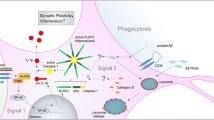Abstract
We hypothesize that amyloid (Aβ) peptide-containing neuritic plaques in the brains of patients with Alzheimer's disease represent chronic inflammatory foci mediated by the actions of the complement system and proinflammatory cytokines. In support of this, in vitro studies show that the (Aβ) peptide is a potent complement activator and that such complement activation leads to the formation of covalent (Aβ)-C3 activation fragment complexes, the generation of the chemokine-like C5a complement activation peptide, and the formation of the proinflammatory C5b-9 complex in functionally active form able to insert into neuronal cell membranes. Other studies show that C5a, together with (Aβ), synergistically augments the release of proinflammatory cytokines from human monocytes. These studies, which provide in vitro support for the hypothesis, are being pursued in an animal model of Alzheimer's disease.
Similar content being viewed by others
References
Arnold SE, Hyman BT, Flory J, Dantasic AR, Van Hoesen GW: The topographical and neuroanatomical distribution of neurofibrillary tangles and neuritic plaques in the cerebral cortex of patients with Alzheimer's disease. Cereb Cortex 1991;1:1047–3211.
Games D, Adams D, Alessandrini R, et al.: Alzheimer-type neuropathology in transgenic mice overexpressing V717F β-amyloid precursor protein. Nature 1995; 373:523–527.
Hsiao K, Chapman P, Nisen S, et al.: Correlative memory deficits, Aβ elevation and amyloid plaques in transgenic mice. Science 1996; 274:99–102.
McGeer PL, McGeer EG: The inflammatory response system of brain: implications for therapy of Alzheimer and other neurodegenerative diseases. Brain Res Rev 1995;21:195–218.
Morgan BP, Gasque P: Expression of complement in the brain: role in health and disease. Immunol Today 1996;17:461–466.
Yasojima K, Schwab C, McGeer EG, McGeer PL: Up-regulated production and activation of the complement system in Alzheimer's disease brain. Am J Pathol 1999;154:927–936.
De Boer JP, Wolbink G-J, Thijs LG, Baars JW, Wagstaff J, Hack CE: Interplay of complement and cytokines in the pathogenesis of septic shock. Immunopharmacology 1992;24:135–148.
Rogers J, O'Barr S: Inflammatory mediators in Alzheimer's disease; in Wasco W, Tanzi RE (eds) Molecular Mechanisms of Dementia Totowa, Humana, 1997 pp 177–198.
Eikelenboom P, Stam FC: Immunoglobulins and complement factors in senile plaques. Acta Neuropathol 1982;57:239–242.
Rogers J, Cooper NR, Webster S, et al.: Complement activation by β-amyloid in Alzheimer disease. Proc Natl Acad Sci USA 1992; 89:10,016–10,020.
Lue L-F, Brachova L, Civin H, Rogers J: Inflammation, Aβ deposition, and neurofibrillary tangle formation as correlates of Alzheimer's disease neurodegeneration. J Neuropathol Exp Neurol 1996:55:1083–1088.
Cooper NR: Biology of the complement system; Gallin J, Snyderman R (eds): Inflammation: Basic Principles and Clinical Correlates, 3rd ed. Philadelphia, Lippincott-Raven, 1997.
Benveniste EN: Inflammatory cytokines within the central nervous system: sources, function, and mechanism of action. Am J Physiol 1992;C1–C16.
McGeer PL, McGeer EG: Inflammation of the brain in Alzheimer's disease: implications for therapy. J Leukoc Biol 1999;65:409–415.
Jiang H, Burdick D, Glabe CG, Cotman CW, Tenner AJ: β-Amyloid activates complement by binding to a specific region of the collagen-like domain of the C 1q A chain. J Immunol 1994;152:5050–5059.
Velazquez P, Cribbs DH, Poulos TL, Tenner AJ: Aspartale residue 7 in amyloid β-protein is critical for classical complement pathway activation: implications for Alzheimer's disease pathogenesis. Nat Med 1997;3:77–79.
Webster S, Bonnell B, Rogers J: Charge-based binding of complement component C 1q to the Alzheimer amyloid β-peptide. Am J Pathol 1997;150:1531–1536.
Bradt BM, Kolb WP, Cooper NR: Complement-dependent proinflammatory properties of the
Author information
Authors and Affiliations
Rights and permissions
About this article
Cite this article
Cooper, N.R., Bradt, B.M., O'Barr, S. et al. Focal inflammation in the brain. Immunol Res 21, 159–165 (2000). https://doi.org/10.1385/IR:21:2-3:159
Issue Date:
DOI: https://doi.org/10.1385/IR:21:2-3:159




